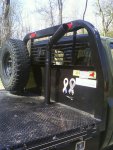Ahhh yes.... the 'Levi's dyno' comes into play here. I have yet to see anyone from my walk in life that has compared before/after HP/TQ results on their truck when going from factory exhaust to red-neck... errr,.... hot rod exhaust.
'Tanner'
Tanner, go back and read his post. He thinks he has more power after he installed an exhaust instead of how it was running before with a "open" exhaust.
Sonic energy is the non-uniform pressure. These pulses in the exhaust manifold upstream of a turbocharger ARE a significant part of the total enthalpy (that is energy) which is extracted by the turbine. Heat and pressure, the "sonic" moniker distinguishes this as dynamic pressure, rather than static pressure most are familiar with.
This is why a turbocharger adds power without significant increase in back pressure. The rather low specific output (155 BHP) from 379 cubic inches and dual exhaust means performance isn't hampered by the mufflers. The total mass flow through the engine is also low due to the low engine speed (3600 RPM).
I'm not sure where you're getting this sonic energy stuff at. Everything I've ever been taught or studied is about the thermal conversion of exhaust energy back to kinetic energy. Sonic energy doesn't have enough potential to move the turbine.
Also you're wrong about the increase in backpressure. As you near the end of a turbo's map, the drive pressure hits and exceeds 1:1. Here's a video of my own truck. The 0-100psi gauge to the left is drive pressure (tapped pre turbo into the exhaust manifold). And the 0-60psi gauge on the right is boost pressure. Notice as I near the 45psi mark. (End of the effective map of the turbo) Pressures match.
[media]http://www.youtube.com/watch?v=G018zl9U-JY[/media]
There's NO way the rest of the exhaust can be any factor in this either. As once the exhaust passes the turbine it's dumped out into a 5" exhaust. No muffler and straight for the most part except for the bend over the rear axle.
The reason turbocharging works so efficiently is due to the fact they convert thermal energy back to kinetic energy. They do this conversion efficiently and without a physical connection to the engine. Approximately 1/3 of the energy of fuel in a ICE is wasted as heat out the exhaust.







